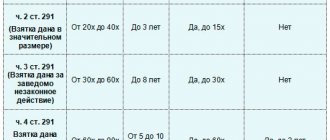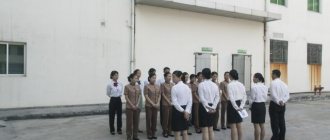- Definition of an accident
- What punishment is provided by law?
- Driver's responsibilities in case of an accident
- When is it permissible to leave the scene of an accident?
- When is it prohibited to leave the scene of an accident?
- Didn't notice the accident? Prove it
- Video
By leaving the scene of a car accident, the driver commits a serious offense. The amount of punishment is determined taking into account all the circumstances. This may result in both administrative and criminal liability. In what cases does a violator face a fine for leaving the scene of an accident, in what cases are there more serious sanctions, and when is leaving the scene of a collision considered acceptable? We'll tell you in the article.
What is considered leaving the scene of an accident?
Not every situation can be interpreted as leaving the scene of an accident. This is primarily due to the conditions under which a traffic accident occurs.
An accident is an event that occurred during the movement of a vehicle or with its participation, during which people were injured or property was damaged. For example, if a neighbor opened his car door and scratched your car parked in the yard, this is not considered an accident. Consequently, a neighbor who has gone home cannot be brought under Part 2 of Art. 12.27 Code of Administrative Offenses for leaving the scene of an accident.
In turn, leaving the scene of an accident is leaving the scene of a traffic accident by one or more of its participants in violation of clause 2.5 of the traffic rules, if the departure occurred:
- before the arrival of traffic police officers,
- before drawing up a European protocol with the second participant in the incident (subject to a number of conditions).
In this case, it is not so important where the contact between the vehicles occurred - in the city, on the highway, in the parking lot, near a gas station or in the yard. It also does not matter how exactly the culprit of the accident escaped - he drove away by car or simply ran away. The fact is that the actions of such a driver constitute an offense under Part 2 of Art. 12.27 of the Code of Administrative Offenses and are the basis for holding people accountable for leaving the scene of an accident.
Driver's responsibilities in case of an accident
A fine of 1,000 rubles can be collected from a driver who violates the traffic rules for actions after an accident. The correct behavior should look like this:
- stop the car in the position it was in after the accident, do not move or remove objects related to the accident;
- turn on the emergency lights;
- place warning triangles at the correct distance from the vehicle;
- find out if there are victims;
- if there are victims, call the traffic police and doctors, if possible, provide first aid yourself, send or take the wounded to a medical facility, if necessary.
However, there are a number of exceptions, also specified in the traffic rules.
What is the penalty for leaving the scene of an accident in 2022?
The driver who left the accident will not get away with a fine. The fact is that such a measure of liability as a fine for leaving the scene of an accident is not provided for by law. But there are other, more severe penalties - from deprivation of a driver's license to imprisonment.
And below in the table we present all the penalties for leaving the scene of an accident in 2022:
Table of liability for leaving the scene of an accident
| Violation | Article | Punishment |
| Left the scene of the accident | part 2 art. 12.27 Code of Administrative Offenses | One of the punishments chosen by the judge:
|
| He disappeared, but then returned before the traffic police arrived. | reclassification of punishment to Part 1 of Art. 12.27 Code of Administrative Offenses | if there was no intent, the judge may impose a fine of 1,000 rubles |
| Didn't notice the accident and drove away | in practice, Part 1 of Art. is more often used. 12.27 Code of Administrative Offenses | the same fine of 1,000 rubles |
| Didn't get a license and ran away from the scene of the accident | part 2 art. 12.27 Code of Administrative Offenses | instead of depriving a driver’s license (which the culprit does not have), the court will order an arrest |
| Escaped while deprived of the right to drive vehicles | same part | administrative arrest for several days |
| Left while drunk | part 2 art. 12.27 of the Code | imprisonment for up to 1.5 years or arrest for up to 15 days |
| Fled away from an accident, causing serious damage to health | part 2 art. 264 of the Criminal Code of the Russian Federation | The court imposes one of the following sentences:
At the same time, the driver is deprived of his license for up to 3 years. |
| Fatal accident | part 4 and part 6 art. 264 of the Criminal Code of the Russian Federation | Penalties depend on the number of deaths:
In addition to the punishment, deprivation of a driver's license for up to 3 years. |
Please note that traffic police inspectors cannot deprive someone of their license for leaving the scene of an accident. The punishment is imposed solely by a judge - a magistrate or district court. Traffic police officers only collect case materials and submit them to the court for consideration.
He disappeared drunk - is that true? Latest news about changes
No. For some time now, information has been circulating on the Internet that, according to the new rules, an allegedly drunken accident is equated to the same as if the culprit fled the scene.
This is not true and fiction. But this “fake” has “legs growing” from slightly different – already official information. The fact is that in the Criminal Code of the Russian Federation there is an article for guilt in an accident with injuries or deaths. Until recently, there were more severe punishments here if there was harm to the health or life of people, and the culprit was drunk. This is logical, isn't it?!
So, a new law recently came into force, according to which stricter punishments await not only a drunk driver, but also if he fled the scene of an accident. And these measures of responsibility are the same for both intoxication and abandonment. Which is also logical, so that drivers in a state of intoxication do not leave the scene of an accident in order to receive a more lenient punishment.
We have a separate special article about this.
Will my license be revoked for leaving the scene of an accident?
Yes, but not in all cases.
Any administrative punishment is imposed only for a guilty act - this is indicated by part 1 of Art. 2.1 Code of Administrative Offences. In this case, it is necessary to determine not just guilt, but intent in committing an unlawful act (Article 2.2 of the Code of Administrative Offenses of the Russian Federation). In our case, the driver must realize that an accident has occurred, but at the same time, without any doubt, leave or run away from the scene of the accident.
However, intent is not always present. And below we will analyze different situations.
What if I didn’t notice the accident and drove away?
It is difficult to say unequivocally what punishment awaits you. In practice, in 2022 you may be either deprived of your license or fined. But often in such cases, the courts meet the drivers halfway and reclassify the case from Part 2 to Part 1 of Art. 12.27 Code of Administrative Offenses of the Russian Federation.
The driver does not face deprivation of his license if:
- the contact of the cars was insignificant - that is, such that you didn’t even feel it, and therefore you drove away,
- As a result of the contact, not a single vehicle was damaged (for example, the mirrors were rubbed in, but there were no chips, cracks, or peeling films on them).
This is explained by the fact that the driver is subject to administrative liability only for those violations for which the driver’s fault is established (Part 1 of Article 1.5 of the Code). In this case, an integral attribute of the form of guilt is intent. And if the driver did not notice the accident and left the scene, he did it unintentionally, which means he cannot be punished by deprivation of his license.
However, in judicial practice there are cases with the opposite outcome. Thus, the Supreme Court upheld the decision of the lower court to deprive a girl driver of her license for leaving the scene of an accident. The lady was backing up and slightly hit a standing car, damaging the rear license plate light. The girl did not find any damage to her vehicle and drove off. As a result, the Supreme Court of the Russian Federation considered the collected evidence in favor of the guilt of the lady driver to be sufficient, rejecting the request for a trace examination. As a result, the girl driver was left without a license for 1 year (Resolution of the Supreme Court of the Russian Federation dated October 16, 2020 N 5-AD20-102).
If the accident was non-contact
Non-contact accidents are considered non-contact accidents in which there was no collision between cars, but the actions of one of the drivers (or pedestrians) constitute an offense:
For example:
- the pedestrian crossed the road in the wrong place, and the driver, trying to avoid a collision with him, crashed into a fence or an oncoming car - after which the pedestrian ran away,
- one driver cut off the other, but the cars did not touch - as a result, the second car owner skidded and crashed into a pole, and the first driver drove away.
What's wrong with that, there was no contact! However, the Supreme Court indicated the need to attract drivers if it was their fault that a non-contact accident occurred and they deliberately fled the scene of the accident:
Let us quote paragraph 9 of paragraph 20 of the Resolution of the Plenum of the Armed Forces of the Russian Federation No. 20:
A driver of a vehicle who has committed a violation of the requirements of the Russian Federation Traffic Regulations, which caused a traffic accident involving other vehicles (another vehicle), may be brought to administrative liability under Part 2 of Article 12.27 of the Code of Administrative Offenses of the Russian Federation, regardless of whether the vehicle he is driving has entered a vehicle into mechanical interaction with other vehicles (vehicle), individuals or material objects, provided that this driver was aware of the fact of the traffic accident, but deliberately left the scene of the traffic accident.
It will be difficult for a driver who leaves the scene of an accident to retain his license. After all, he will automatically be a participant in an accident, which means he must stop the car and fulfill all obligations in accordance with paragraph 2.5 of the traffic rules after a traffic accident. Otherwise, the culprit of the accident faces deprivation of his license for leaving the scene of the accident.
I left, but returned before the traffic police arrived?
The fact of returning will work in your favor. Will it be possible to avoid liability under Part 2 of Art. 12.27 of the Administrative Code, depends on the specific situation:
- if you returned before the arrival of the traffic police crew and the second participant is also there, you are unlikely to be charged for leaving an accident,
- if you return, and the police are already filing an accident according to the words of the second participant in the accident, you may be recognized as having left the scene of the accident, but, most likely, they will not see intent and will be charged under Part 1, and you will get off with a fine of 1,000 rubles.
Finally, the third situation. If you took the victims to the hospital, but then never returned to the scene of the accident for registration, your actions also constitute grounds for deprivation of a driver’s license (paragraph 6 of Article 20 of the PPVS No. 20). So it's in your best interest to go back.
What if the other participant and I separated after the accident?
You can leave the scene of an accident only if a number of conditions are met. They are related to the registration of the European protocol.
According to paragraph 2.6.1 of the traffic rules, drivers may not report the incident to the traffic police, but go about their business only if it is possible to register an accident without involving police officers. In other words, we are talking about drawing up a notice of an incident (European protocol), as part 1 of Art. 11.1 Federal Law On Compulsory Motor Liability Insurance.
When can you leave:
- only two vehicles participated,
- there are no injuries or deaths, and the damage was caused only to the specified vehicle,
- both cars have valid MTPL policies,
- damage from an accident does not exceed 400 thousand rubles.
Only if you meet the above conditions for registering a European protocol in 2022, you can drive away without consequences for leaving the scene of an accident. And in this case, you will not face deprivation of rights or arrest under Part 2 of Art. 12.27 of the Code.
If you decide to compensate for the damage on the spot, do not forget to draw up a receipt. Otherwise, the second participant in the accident may simply set you up. For example, after you give him the money without a receipt and drive away, he may come back, call the traffic police and tell them that you drove into his car and fled the scene of the accident. In this case, you have a real prospect of being left without a license and switching to public transport for a year and a half.
Did I act under extreme necessity?
This justifies you in the eyes of the traffic police and the courts. But, as you understand, no one will take your word for it, so you need to stock up on evidence of actions in a state of emergency.
For example, you were forced to personally take a victim of an accident to the hospital because it happened on the highway and there was a long wait for an ambulance. It is advisable to make two calls before leaving. One to the traffic police, the second to your insurance company. Next, you need to confirm that you visited a medical facility. An entry in the visitor log, witness statements, data from cameras, etc. would be suitable.
Once you have transported the victims to the hospital, you must return to the scene of the accident for further processing. In this case, there is every chance to count on classifying your actions as a state of emergency (Article 2.7 of the Code of Administrative Offenses of the Russian Federation) and avoid deprivation of rights or arrest for intentionally leaving an accident.
What if I am not the culprit, but the victim?
As we found out above, administrative penalties are imposed only for a guilty intentional act. The culprit has an intention - it is beneficial for him to escape from the scene of the accident and hide traces of his presence.
Does the victim in an accident have such intent? Of course not! True, the “victim” status is also absent, since the incident is not documented in any way. In practice, the traffic police or the court may also impose liability for the accident on the alleged victim. Including, if he leaves the scene of the accident, and the real culprit notices the damage, returns and calls the traffic police.
But in general, in judicial practice in 2022, victims are charged for leaving the scene of accidents much less often than perpetrators. However, it's not worth leaving.
When is it prohibited to leave the scene of an accident?
You cannot leave the scene of the collision until the traffic police arrive, regardless of the absence or presence of victims. The only exceptions are those cases described above.
However, there are situations when it seems that leaving does not threaten the driver. As a rule, this is not the case. Most often, problems arise in the following cases:
- The person responsible for the accident left the scene of the collision. If the damaged car also leaves, then the offender can subsequently contact the traffic police and report the damage. In this case, it will be difficult to prove that you are right.
- The participants in the accident “verbally” agreed on the absence of claims, without issuing a receipt, without recording the damage and the diagram of the accident in accordance with the rules. In this case, it is possible that one of the participants will return to the scene of the collision and call the traffic police, accusing the second of fleeing.
- There was a collision with a pedestrian, and he fled. Subsequently, the injured person can file a complaint with the traffic police. Then the driver who gets away may lose his license or go to jail.
- The car was dented in the parking lot, the culprit disappeared. In this case, the driver who damaged the car can contact the traffic police and shift responsibility for the accident to the injured party.
If any of the above situations arise, the driver should remain in place and report the incident to the traffic police. It is important to document in writing and thoroughly the fact that there are no claims between the parties to the accident. This will help you avoid being arrested or having your driving privileges revoked.
What to do if the culprit of the accident disappeared, and traffic police officers are in no hurry to look for him?
Practice shows that traffic police officers are not very actively looking for those who fled the scene of an accident. Most often due to the inability to identify the runaway driver. So it turns out that the search for the person who left is formal (in the office). Therefore, do not expect that there will necessarily be any progress in your case. Your task is to organize an independent search for the fugitive.
What action should the victim take?
So, how can you find out the license plate number of an escaped car, and in some cases, the identity of the villain who was driving:
- Determine the registration number, make, model and color of the vehicle whose driver left the scene of the accident - information is needed primarily for insurance compensation,
- View the footage from the dash cam in your car (perhaps another driver was getting out of the car before fleeing and his face was captured on your dash cam),
- Look for traffic or street cameras at the scene of the incident: on poles, entrances, schools, stores, etc.
- If there are few clues, find eyewitnesses of your accident in car or city groups on social networks (perhaps the witness recorders recorded the car or the face of the accident participant on video).
- Find witnesses in the area of the accident - write down their contact information and give them your phone number for contact.
- Also look for cars with characteristic damage in neighboring yards. If you suddenly find such a car, take a photo of it from all sides and record the license plate number (for the traffic police).
But there is one subtlety with searching for street cameras. Their owners will not just give you a recording of the incident. And you don’t have to do this! Your task is to politely and persistently ask them not to delete (overwrite) the entry for the date you need. Then you will have to submit a petition to the traffic police to seize these records for further study. Based on your application, the traffic police inspector will seize video recordings and view them.
Is it worth going in pursuit?
Depends on the situation. If you remember or record the license plate number of the missing driver, then there is no need to go after him. Otherwise, you risk creating an emergency situation during the chase. And it’s not a fact that you will even catch up with someone who left the scene of an accident.
But if you didn’t see the license plates, it makes sense to go after the fugitive with one single goal - to remember the license plate number of his car for further compensation for damage under compulsory motor liability insurance.
And, of course, upon completion of the pursuit, you must return to the scene of the accident and call the traffic police. These actions will confirm that you have no intention of leaving the scene of the incident. But the escaped driver will have such intent (unless he returns before the arrival of the traffic police).
Circumstances to prove guilt
A license can be revoked for escaping from the scene of an accident only when all the circumstances of the administrative case have been established and there is reliable evidence of the participation of this particular vehicle in the accident under the control of a specific driver.
Presence of vehicle contact with each other
The following circumstances will prove the participation of the escaped vehicle in the collision:
- testimony of eyewitnesses who recorded the make and number of the car;
- recordings from the registrar or street cameras;
- presence and proportionality of mechanical damage on machines;
- traces of paintwork at the point of contact;
- compliance with the paintwork on the vehicle suspected of being involved in a collision.
In controversial cases, the investigator has the right to order a traceological or chemical study, the results of which will give an unambiguous answer as to whether there was contact between these vehicles.
Proof of who the driver was
If an abandoned car is found with signs of participation in an accident, the traffic police investigation authorities check it for involvement in the accident and determine the person driving the car. The first suspicions fall on the owner of the car and persons included in the compulsory motor liability insurance. Billing a telephone number, recordings of external cameras and eyewitness testimony will help determine who specifically drove the car and fled the scene. If the owner of a car reports the theft of a vehicle, which involved an accident with serious consequences, a criminologist goes to the place where the car was found to take fingerprints and sweat secretions. The absence of signs of vehicle theft and the absence of other people's fingerprints on the vehicle controls allows us to conclude that the driver intends to evade responsibility.
Important! Knowingly false denunciation and knowingly false testimony are criminal offenses.
Presence of damage to vehicles
One of the signs of an accident is the presence of financial damage. To determine its size, damage is assessed by the insurance company or an independent institution that has the right to do so. The absence of damage or its insignificance excludes the offense.
Presence or absence of intent
The investigator makes a conclusion that leaving the scene of an accident was unintentional based on the inspection materials. Proven circumstances that exclude an intentional offense qualifying under Art. 12.27 of the Administrative Code:
- legality of leaving the scene of an accident;
- non-obviousness of the accident for the driver;
- registration of the European protocol.
Will the insurance company pay out under compulsory motor liability insurance if the culprit fled the accident?
Yes, maybe not. It all depends on the prevailing circumstances and the conditions under which insurance companies compensate for damage after an accident.
When can you expect payments under compulsory motor liability insurance:
- the traffic police identified the car of the escaped driver (according to license plate numbers),
- this car has insurance (and it is valid),
- The victims themselves or relatives of those who died in road accidents apply for compensation - payments are made not by the insurance company, but by the Russian Union of Auto Insurers (RUA).
The insurance company will also cover damage to your vehicle if you signed up for a comprehensive insurance policy.
What documents about an accident does the traffic police inspector draw up?
The traffic police inspector draws up:
- Incident scene inspection protocol - if people were injured. A diagram of the place where the administrative offense was committed is attached to the protocol.
- Explanations of all participants and witnesses of the accident about the circumstances of the incident.
- Information about an accident (certificate of an accident), which is issued to all participants in an accident.
- Protocol on an administrative offense if the driver disputes the offense.
- A resolution in a case of an administrative offense, if the circumstances of the case are established on the spot, without an administrative investigation.
It is important to ensure that all documents are completed correctly. Sometimes the police conduct an administrative investigation to establish the circumstances of the accident. The documents will determine who is found to be at fault for the accident.
- The diagram of the traffic accident must correspond to reality. If you believe that it was drawn up incorrectly, indicate this in the diagram itself - it will be given to the participants in the accident for signature.
- If you believe that someone involved in an accident is under the influence of alcohol or drugs, report this to a police officer and request an intoxication examination.
If people were injured in an accident, then the participants in the accident are subject to mandatory examination for intoxication.
- Your explanations must be indicated by yourself or accurately recorded in your own words;
- Information about an accident must correctly record the data of all participants in the accident, as well as damage to vehicles.
If there is no violation in the actions of the drivers, the inspector issues a decision to refuse to initiate proceedings for an administrative offense. Otherwise, the driver is brought to administrative or criminal liability (in case of death or serious harm to health).
Information about the accident and a resolution in the case of an administrative offense (or a determination of refusal) must be provided to the insurance company for compensation for damage.
How to avoid deprivation of rights for leaving the scene of an accident in 2022?
Now we’ll tell you about life hacks on how not to be left without a license if you fled the scene of an accident. These methods are not illegal in 2022 - they are just loopholes in the law that allow you to avoid punishment for any administrative offense.
And the first life hack is related to deadlines.
Working way!
Its essence is that you are hiding from the traffic police officers and after a certain time you can no longer be held accountable for leaving the scene of an accident.
According to the law, a decision to bring a person to administrative responsibility cannot be made by a court later than 3 months after the offense (Part 1 of Article 4.5 of the Code of Administrative Offenses of the Russian Federation). So, if you fled the scene of an accident, but within three months you were not found and no ruling was made against you, the court itself will dismiss the case due to the expiration of the statute of limitations.
This, for example, happened in the Irkutsk region, where a driver was able to evade responsibility for leaving the scene of an accident. By decision of the Chunsky District Court No. 12-37/2020, the case was dismissed due to the expiration of the statute of limitations.
Another decision, this time from the regional court in Yaroslavl. The motorist who left the scene of the accident was also “rehabilitated” due to the expiration of the statute of limitations for prosecution. Although the driver based his defense on the basis of notifications about court hearings that did not arrive on his phone (Decision of the Yaroslavl Regional Court No. 30-1-77/2021 of March 15, 2022).
What if they found me?
Even if you were called/delivered to the traffic police department to give evidence, you still have the opportunity to avoid deprivation of your license for leaving an accident. To do this, you have the right to use Art. 51 of the Constitution of the Russian Federation:
No one is obliged to testify against himself, his spouse and close relatives, whose circle is determined by federal law.
Thus, you have the opportunity granted by law not to report who was actually driving the getaway car - either you yourself or one of your relatives. And according to the 2022 law, you will not face anything for refusing to point out the culprit. Meanwhile, traffic police officers will have to collect other evidence. If this evidence is not available and 3 months have passed since the accident, you will not be able to be deprived of your driver’s license or arrested.
But there is one more, third (and most difficult) loophole, how not to be left without rights.
Replacement of deprivation of rights to arrest
The essence of the third method is that you petition the court to replace the deprivation of rights with an administrative arrest, and the court decides whether to grant your request or ignore it.
The difficulty is that arrest is a more severe sanction than deprivation of a driver’s license (Part 2 of Article 3.9 of the Administrative Code). Courts order arrest only in extreme cases. For example, if you have never received rights or have previously been deprived of them. Or a car is your only source of income, and without a driver’s license you will not be able to provide for your family. In these and other cases, the court orders administrative arrest for up to 15 days under Part 2 of Art. 12.27 Code of Administrative Offences.
A Stavropol driver managed to get away with 2 days of arrest instead of deprivation of his license for leaving the scene of an accident (Resolution No. 5-385/2021 of March 4, 2022). And earlier, in the same region, another driver received the same two days of arrest for a similar offense.
Progress in court
When checking the fact of leaving the scene of an accident, the traffic police investigator identifies the violator by using technical means of recording (recorders, cameras) and interviewing eyewitnesses. After the identity of the violator is established, the material is sent to court. By default, the case of violation of Art. 12.27 of the Code of Administrative Offenses is considered by the magistrate of the territory where the accident occurred. At the request of the defendant, the administrative case may be sent to his place of residence or vehicle registration. Having received an administrative case, the judge has the right to make one of the following decisions:
- refer the case to jurisdiction;
- return to the traffic police department to eliminate deficiencies;
- stop production;
- schedule a meeting.
The person held accountable is notified of the place, date and time of the meeting. Appearance in court is carried out without delay. You must have an ID with you. The trial will take place without the participation of the person involved, if he has been duly notified. The meeting is open and everyone is allowed to attend. The person involved has the right to use the services of a defense lawyer at any time after the initiation of a case regarding an administrative violation.
The judge considers the case alone, having previously explained to the participants their rights. Before the hearing, participants have the right to submit a written request. The presence of traffic police officers is not necessary, but at the request of the person involved or his defense attorney, the judge may oblige the inspector to appear in court.
During the hearing the judge:
- announces the protocol on the violation;
- hears testimony from the driver held accountable;
- listens to eyewitness testimony;
- gets acquainted with other inspection materials.
Having retired to the deliberation room, the judge prepares a ruling, reads it and hands it to the interested party. The decision options are as follows:
- assignment of punishment;
- termination of administrative proceedings;
- sending materials according to jurisdiction.
A citizen has a ten-day period to appeal the court decision. The decision of the second court is final, its verdict comes into force immediately and is subject to appeal solely by way of supervisory review.
Will it be possible to avoid recourse from the insurance company?
The insurance company has the right to bring a recourse claim against the culprit for the amount of compensation for damage to the victim, including if this culprit left the scene of the accident (clause “d”, part 1, article 14 of the Federal Law No. 40 On Compulsory Motor Liability Insurance). But in some cases, regression can be avoided.
Let's look at two examples:
- OJSC AlfaStrakhovanie tried to recover payments from a legal entity through a recourse claim. They brought a copy of the accident certificate to the court. But the court indicated that such a certificate alone is not enough - especially an administrative case under Part 2 of Art. 12.27 of the Code of Administrative Offenses of the Russian Federation was not even initiated against the driver of a legal entity, and the driver himself had not previously been brought to justice by the court for leaving the scene of an accident. Thus, the recourse was denied (Resolution of the Thirteenth Arbitration Court of Appeal dated February 22, 2018 No. 13AP-1720/2018 in case No. A56-76089/2017)
- And in the Kurgan region, PJSC ASKO-INSURANCE was able to recover 116,688 rubles from a driver who fled the scene of an accident as a recourse claim, even though the magistrate court dismissed the case due to the expiration of the period for bringing the culprit to justice. After all, in this case we are talking about a civil process.
Thus, it is possible to avoid recourse from the insurance company for leaving the scene of an accident only in one case - if the driver’s fault is not established and he is not held liable under Part 2 of Art. 12.27 Code of Administrative Offences.
If intent is established and there is a court decision on deprivation of rights or arrest, it is unlikely that it will be possible to wriggle out of the insurance company’s recourse claim. But even in this case, you have a chance for a deferment or installment plan. And if there is no money, then the insurance company is unlikely to be able to recover these amounts from you.
Return of a driver's license after revocation
In 2022, there is a certain procedure for returning a seized driver's license:
- The court order issued in hand indicates the date when the punishment for leaving the scene of an accident ceases to apply. You can contact the authority that took away the rights the very next day after this date. But you need to prepare for the visit in advance.
- Documents will be returned only if you have certificates confirming that you have passed repeated exams on your knowledge of traffic rules. You can take this exam a month before applying to the traffic police.
- Additionally, a package of documents is provided: a Russian passport to confirm the driver’s identity; a certificate confirming the transfer of the certificate to the traffic police department; photocopy of the court order with the end date.
Please note:
A medical certificate may be required. Despite the fact that this document is not strictly mandatory, it will still have to be provided when the inspector makes a request, therefore, you should undergo a medical examination in advance.
A prerequisite for returning a driver's license is a re-test of knowledge of traffic rules. The exam must be passed successfully, otherwise you will not be able to obtain your license the first time. If errors were made in the answers, a retake is scheduled after 7 days.
Reader Questions
Anna, Rostov-on-Don. Two days ago another car rear-ended my car. I examined the car and didn’t notice any major damage, except for abrasions on the bumper. I didn’t call the traffic police, I left. Today they called me to the traffic police and said that I drove into that car while moving in reverse. During the accident two days ago, there was no significant damage to the second car, but today I saw that its headlight was broken, its fender and hood were dented. The inspector said that I was facing the loss of my driver's license for running away. Help with advice.
Answer: Formally, your actions contain signs of an offense provided for in clause 2.6 of the Russian Traffic Regulations. You had to call the traffic police or fill out a Europrotocol. If you fail to fulfill your duties as a driver in an accident, you are subject to the sanctions of Art. 12.27 of the Administrative Code, which provides for the deprivation of rights to drive vehicles. You need to request a trace and chemical test as part of your accident investigation to prove that there was no damage as a result of your actions.
Sergey, Vladimir. I leave the car in the yard of the house. When I came out in the morning I discovered damage on the driver's door. There is a recording camera above the entrance door. Will her recording help identify the culprit of the accident?
Answer: Without moving the car, contact the traffic police and report the incident. The inspector will inspect the car, draw up a diagram of the incident and a protocol for examining the accident scene, and request a video camera recording. If the make and license plate number of the car that damaged your car and left the scene of an accident is visible on the recording, he will be put on the wanted list. The driver will be held liable and their insurance company will pay you for the damages.
Limitation periods
The time during which an order can be issued against an offender is called the statute of limitations and is 3 months. After this period ends, they will definitely no longer look for the culprit and bring him to punishment, but only administratively, it will be impossible. In the event of criminal liability, this rule does not apply. If the culprit is hiding from justice, he may be put on the wanted list.
The term “limitation period” means a period of time regulated by law and allowing the injured party to challenge in court the impunity of the person who caused the damage, and the latter to provide exculpatory facts and try to appeal the punishment. The total claim period is 3 years. Depending on the subject of the dispute, a special period may be allotted, after which the jurisdiction of this case will be terminated.







